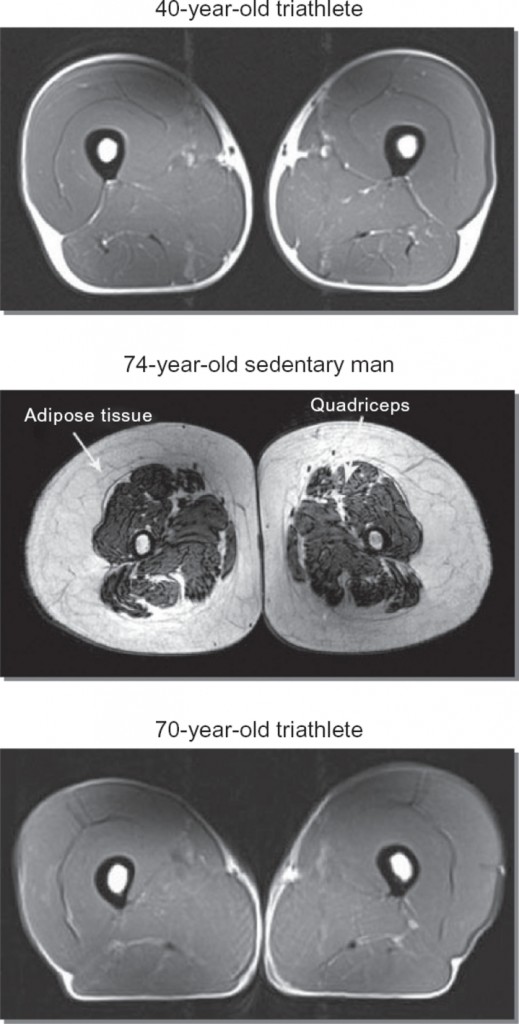This week, read about how exercise keeps us young, celebrities that promote science, more health benefits for blueberries, top diets of 2014, bone broth, and more.
Exercise Keeps Us Young
When I lived in San Diego, I was amazed at the large numbers of older cyclists who were so fit and speedy that they rivaled many of their younger counterparts. Their sculpted legs certainly didn’t show their real age! I’m living in Ottawa now, and one triathlon series I participate in requires participants write their age on their calf – and again, I’m often surprised at the disconnect between the high number on such a powerful-looking muscle. New research studied the phenomenon of the fit older cyclist, and found that cycling may indeed keep your body younger than its c alendar years.
alendar years.
Researchers from College London and the University of Birmingham in the U.K. found that active older people resemble much younger people physiologically. They studied very active cyclists aged 55 to 79, collecting extensive physiological information that typically declines with aging, and found that exercise level has a strong impact on the relationship between ageing and physiological function. (Gretchen Reynolds, New York Times reporting on The Journal of Physiology, 6 JAN 2015 )
You don’t need to be a competitive cyclist to reap rewards: investigators studied “serious recreational riders but not competitive athletes” (men could ride at least 100 kilometers/62 miles in 6.5 hours, and women 60 kilometers/37 miles in 5.5 hours). Although this study was conducted in cyclists, it’s likely that the benefits of activity are similar for other sports.
Here is an impressive image from a study conducted in 2011 looking at how exercise preserves lean muscle mass in masters athletes. Investigators looked at high-level athletes aged 40 to 81 years who trained about 4 to 5 times/week. MRI scans of the athletes’ quadriceps showed that these athletes preserved muscle mass with age, suggesting that muscle mass and strength do not decrease as a function of aging alone, but likely reflect inactivity and chronic disuse of muscles.

Interested in learning more about Masters athletes and their training? Check out my Masters Athletes page.
More Benefits to Blueberries
Blueberries will add brilliant colour and flavour to many dishes, and are great on their own. Abundant in vitamin C, fiber, antioxidants, and low in calories, blueberries are also nutritional powerhouses. Many studies have associated various health benefits with the protective compounds found in blueberries.

A new study published this week in the Journal of the Academy of Nutrition and Dietetics suggests that daily blueberry consumption might improve blood pressure and arterial stiffness in postmenopausal women with pre- and stage 1-hypertension.
You can enjoy blueberries many ways, and frozen blueberries are a convenient and tasty way to enjoy this fruit when they aren’t in season. This lemon blueberry cake may not be the most healthful way to incorporate blueberries into your diet, but it’s healthier than most cakes – serve a small portion with extra blueberries on the side.
More Links of Interest This Week:
From Paleo To Plant-Based, Report Ranks Top Diets 2015. Good expert panel, and evidence-based reviews. Rankings are here. (U.S. News Health)
Not all are like Gwyneth (thankfully)! Celebrities that promote science – including will.i.am, Trey Parker and Matt Stone (South Park), They Might Be Giants, Alan Alda, and more. Great list (Brian Dunning, Skeptoid).
6 Habits That Can Prevent 70% of Heart Attacks in Women. Looking at data from the Nurses’ Health Study II (which followed the health habits of nurses from 1991 to 2011), researchers identified the following habits as being protective of heart disease: not smoking, having a normal body mass index, getting at least 2.5 h of exercise each week, watching television ≤ 7 h/week, having a healthy diet (based on the Healthy Eating Index 2010) and limiting alcohol to a drink or less per day. (Time reporting on Journal of the American College of Cardiology 2015;65(1):43-51.
The one chart you need to understand any health study. Excellent information in this piece. (Julia Beluz & Steven Hoffman, Vox.com)
Should You Eat Whole-Wheat Pasta? 5/5 experts say yes. Just be sure to top your pasta with a veggie-full sauce! (Time)
Higher altitude not necessarily better for athlete training. Although altitude training is popular with distance and team athletes, there is not a lot of published research on the benefits. This study in team-sport athletes found that a modified altitude (4000m) where athletes can perform adequate high intensity training will result in the best adaptation. (Int J Sports Physiol Perform. 2014 Sep;9(5):857-62).
BONE BROTH – Trend/Fad Alert. Featured in the New York Times this week, bone broth appears to be the new food that cures all, and is popular with the Paleo crowd. If you like the taste, sip bone broth, but the health claims don’t hold up to any scientific scrutiny, as explained by Dr. David Katz and the Nutrition Diva Monica Reinagle.
Beautiful art will make you want to eat your fruits & veggies! (The Independent)
Eating more whole grains linked with lower mortality, especially cardiovascular disease (JAMA Intern Med. Jan 5, 2014).
See More Issues of This Week in Food, Health, and Fitness
Share This: